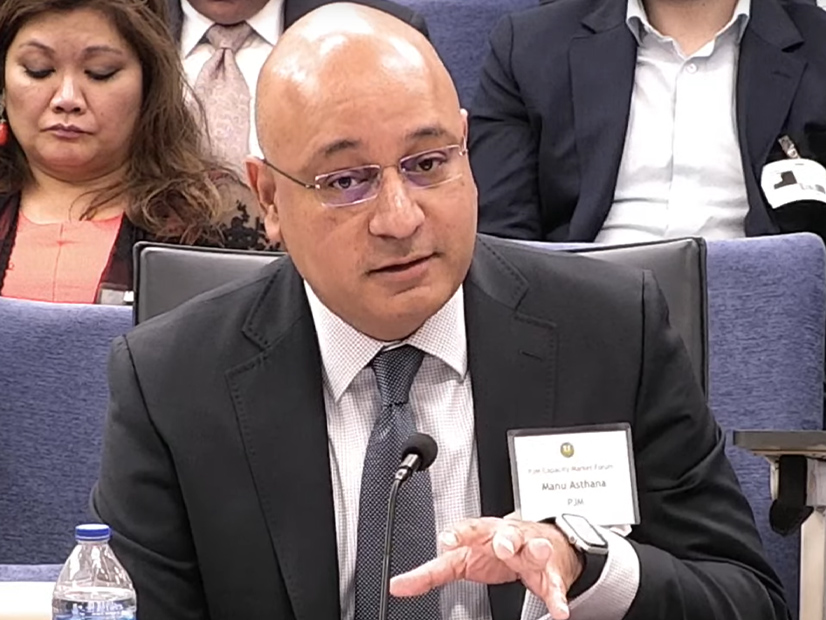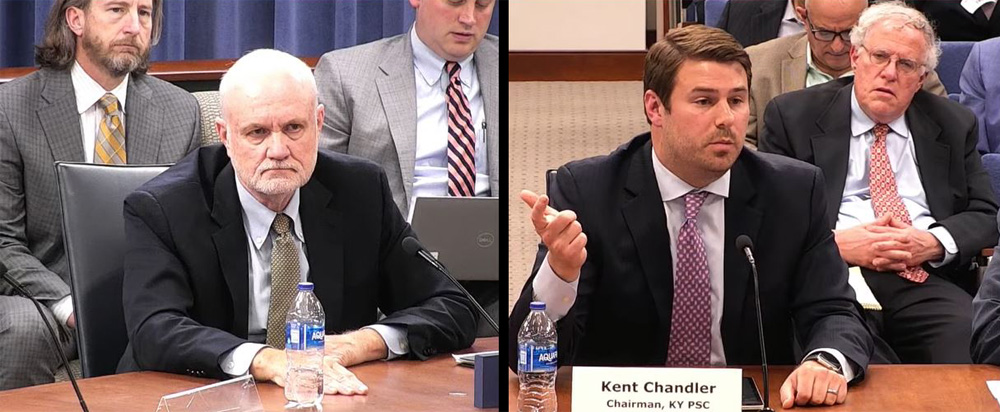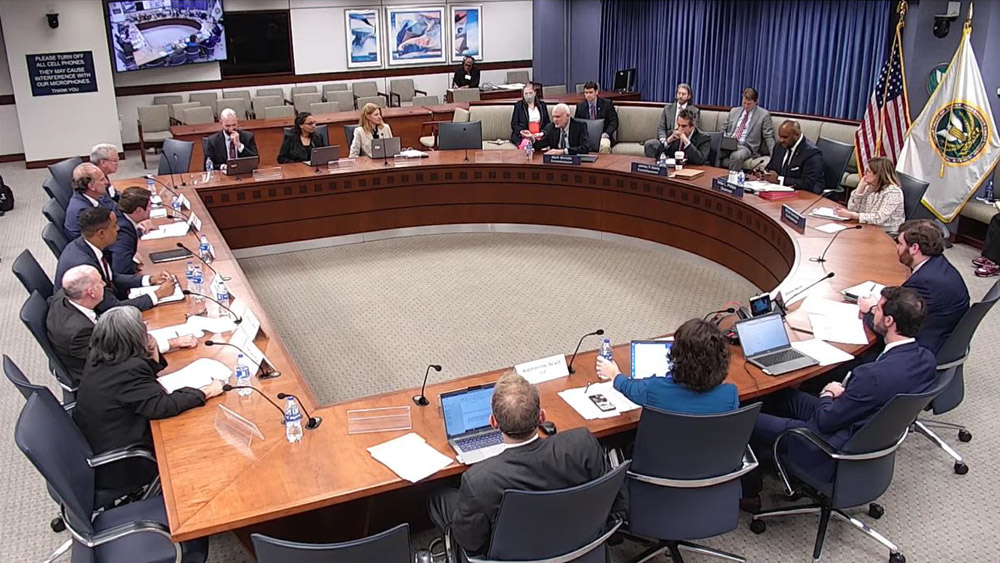
PJM officials and stakeholders told FERC Thursday they oppose abandoning the RTO’s capacity market but disagree over the degree to which it needs to be changed.
The four FERC commissioners heard from 20 RTO officials, state regulators and other stakeholders during a nearly five-hour “Capacity Market Forum,” which the commission scheduled in response to concerns over the RTO’s ability to maintain resource adequacy as dispatchable coal and gas-fired resources retire and are replaced by renewables (AD23-7).
“NERC and PJM and others have warned us, early and often, that current forecasts could lead to a supply gap in certain regions over the next few years caused by early plant retirements and far slower development timelines to bring new resources online,” FERC Chair Willie Phillips said in opening the session.
Commissioner Mark Christie, a former Virginia regulator, questioned whether PJM should consider an alternative to the capacity market.
“The statement that the PJM capacity market is fundamentally sound — it just needs some tweaks — this is now the 19th consecutive year I’ve heard that,” he said. “… As we look out to the future … is the PJM capacity market something we can just keep sticking some bubble gum and some rubber bands [to] keep the thing going?”
Marji Philips, senior vice president of wholesale market policy for LS Power, said the market is “broken” because the introduction of intermittent generation means it no longer comprises “fungible” products.
Consultant James Wilson, who represents state consumer advocates, acknowledged PJM is facing a transition but said the market has “enormous excess capacity” and noted that other regions such as California have integrated far higher proportions of wind and solar power. “The house is not burning,” he said.
Independent Market Monitor Joe Bowring also defended the market but said it needs more than “tweaks,” calling Capacity Performance a “failed experiment.”
During Winter Storm Elliott in December, he said, new combined cycle generators performed worse than old combined cycle plants. “There’s no excuse for that,” he said.
Kent Chandler, chair of the Kentucky Public Service Commission, said the capacity market is only part of PJM’s challenges.
“Even if you fix the capacity market, even if you fixed [resource] accreditation, you’re still going to have gas-electric coordination issues,” he said.
He cited Philips’ criticism that the Intercontinental Exchange is requiring generators to purchase gas four days in advance before the Independence Day holiday because July 4 falls on a Tuesday.
“You know, I’m happy that the gas market is apparently good to have a very enjoyable long weekend on Fourth of July,” he said. “But if we have system issues, that’s going to be a problem. … People are going to have to go find their old Rolodex and try to get ahold of people.”
Energy Landscape ‘Changing Dramatically’
Speaking during the first of three panels, PJM CEO Manu Asthana said the capacity market has historically achieved its goal of sending the price signals needed to incentivize generation where it’s needed, yielding a grid that’s remained reliable even as NERC reports that large portions of the country are at elevated risk this summer.
“Having said that, the energy landscape is changing, and it’s changing dramatically. Policy choices are resulting in accelerated retirement of the generation we use to manage our grid today, and frankly policy choices are chilling investment in new dispatchable generation,” Asthana said.
Asthana said the capacity market can continue to function alongside renewable incentives, so long as accreditation and risk modeling are done properly to ensure that existing resources are valued correctly.
Asthana was joined on the panel by NERC CEO Jim Robb, former FERC Commissioner Phil Moeller, now executive vice president of the Edison Electric Institute, and Greg Poulos, executive director of the Consumer Advocates of the PJM States (CAPS).
Robb said NERC has found that reliability risk has been increasing across the country over the past five years, referencing a May report warning of an elevated potential for insufficient reserves in many regions. (See NERC Warns of Summer Reliability Risks Across North America.) Although PJM was not identified as being at risk, he said its identification of 40 to 50 GW of capacity that could be retiring by 2030 means it could soon be on the map.
The traditional one-outage-in-10-years reliability metric is becoming outdated and needs to be replaced with a focus on providing energy in every hour, he said. Grid operators also need to improve planning around how extreme weather is modeled, he said.
“We need to make sure investments that are needed to maintain reliability purposes are compensated for and reflected in the design of the markets. Markets have demonstrated an incredible ability to drive out inefficiency, but they really haven’t demonstrated their ability to reward the reliability investments that are going to become increasingly valuable as an insurance policy against extreme weather events and common condition challenges such as wind droughts and solar droughts,” he said.
In NERC’s post event analysis of the December 2022 winter storm, 2014 polar vortex and other major storms, Robb said natural gas availability has been an issue. He said the gas distribution system performs well at its historical role of keeping pilot lights lit, but it was designed in a time when it was a niche fuel for energy production.
“Right now natural gas is the single largest fuel for power generation, and power generation is the single largest customer of the natural gas industry. Every winter event we’ve analyzed has had the supply of natural gas to power generation and the ability of that system to perform to meet the needs of customers as a common theme. … At some point we’ve got to take this problem on, but it’s a bigger problem than any of us can solve individually,” he said.
Moeller said jurisdictional questions make addressing coordination between the electric and gas industries complex. But if the cause of winter deliverability issues is on the transportation side, rather than gas production, there may be solutions such as how force majeure is declared and transparency when outages occur, he said. He expressed hope that work the North American Energy Standards Board is engaged in will yield solutions the commission can act on.
Poulos cautioned against a focus on retaining existing generation, arguing that PJM should incentivize the entry of reliable resources, rather than picking and choosing resource types.
Commissioner Christie said the capacity market’s “constant state of churn” is undermining investment in new resources.
“The big problem PJM faces is because you’re a big multistate RTO and your problem is not economic … it’s political. PJM has 13 states and D.C., and the policies of those states have diverged tremendously since the first time [the Reliability Pricing Model] was approved,” he said. “Wouldn’t an SPP model be better for reconciling the different state policies and let them figure out what to build and what to buy, as opposed to trying to hold this thing together with all these states diverging?”
Asthana said PJM is set up to accommodate fixed resource requirements and bilateral contracts, while retaining the capacity market for load that’s open to retail choice and maintaining reliability across a large geographic area.
Bowring and Poulos agreed, saying that the capacity market has reduced prices for consumers while preserving reliability while other regions experience elevated risk.
Critical Issue Fast Path Process
On a second panel, representatives of power providers, environmental groups and state consumer advocates debated the solutions the RTO is considering through the critical issue fast path (CIFP) stakeholder process.
Adam Keech, PJM’s vice president of market design and economics, said the core of the RTO’s CIFP proposal includes improving risk modeling by moving away from the assumption that the peak load and reliability risk are aligned. PJM also seeks to improve accreditation to better reflect what capacity resources will be available when needed and to rework performance incentives to align them with the market seller offer cap. At the CIFP meeting on Wednesday, PJM also proposed a shift to a seasonal capacity market to account for the identification of higher risk in the winter.
Glen Thomas, president of the PJM Power Providers (P3) Group, said accreditation is important but needs to be accompanied by changes to allow generators to recover costs, reflect risks in their bids and limit the potential of demand side market power.
Todd Snitchler, CEO of the Electric Power Supply Association, said accreditation of all resources, thermal and intermittent, must be improved.
“If load is going to grow, you’re going to need more, not less [generation]. You’re going to need both and, not either-or. But certainly it suggests that you’re going to need certain performance characteristics that will enable your system to operate reliably,” he said.
Michelle Bloodworth, CEO of coal power industry group America’s Power, agreed, saying that generators likely to retire under pending state and federal policies will take valuable contributions to reliability with them.
“Whether that’s coal or another thermal resource, those attributes are being lost that PJM still needs,” she said.
The Sierra Club’s Casey Roberts said accreditation should account for fuel availability, saying that if gas-fired resources cannot procure fuel on short notice, they may not be as flexible as believed.
Susan Bruce, of the PJM Industrial Customer Coalition, said while many consumers support a seasonal market, there has to be a focus on the drivers of winter risk.
“I think there is interest in a seasonal auction from a customer perspective. However, getting that cost allocation piece right is complex and important, and just replicating what we have for summer to winter I don’t think is the solution, because the reason why we have winter risk is because we have performance issues,” she said.
Commissioner Allison Clements questioned what role the interconnection queue is playing in the pace of new resource development.
Abigail Ross Hopper, CEO of the Solar Energy Industries Association, said queue challenges remain significant. There will likely be a significant period of time when few new resources will be constructed because of the amount of time it takes to get approved for interconnection, she said.
LS Power’s Philips said PJM’s market rules do not reflect the realities of demand response and peaker plants, which tend to be rarely called upon and be price capped when they are dispatched.
“This market is not addressing the reality of who needs the money, and it’s not sending the price signals,” she said.
Chair Phillips questioned whether PJM is considering changes that can address some of the issues behind Winter Storm Elliott, including the sharp drop in temperatures.
Keech said PJM is using a longer weather history lookback to capture cyclical patterns and tying reliability risk and generator performance to weather. It also is looking at options outside the capacity market, including notification to gas units, scheduling and modeling uncertainty in the energy and reserve markets and the costs that are recoverable for reserve commitments, such as fuel procurement.
A third panel featured state regulators and public advocates, including Kentucky’s Chandler; Ohio Commissioner Dan Conway; New Jersey Commissioner Zenon Christodoulou; D.C. Public Service Commission Chair Emile Thompson; William Fields, deputy people’s counsel for Maryland; and Ruth Ann Price, deputy public advocate for Delaware.





